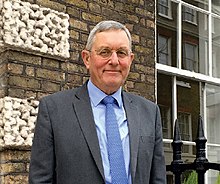John Edward Curtis
John Curtis (b. 1946) is an archaeologist and museum curator specialising in the archaeology and history of Iraq and Iran c. 1000 – 330 BC.
John Curtis | |
|---|---|
 | |
| Citizenship | British |
| Alma mater | University of Bristol (BA) University of London (PhD) |
| Occupation | CEO of The Iran Heritage Foundation |
| Website | Iran Heritage Foundation |
Career
He was educated at Collyers School Horsham, the University of Bristol (BA) and the Institute of Archaeology, University of London (postgraduate diploma, PhD). He was a Fellow of the British School of Archaeology in Iraq 1969-71, and joined the British Museum in 1971. He was Keeper of the Middle East Department 1989-2011,1 and Keeper of Special Middle East Projects 2012-2013. He became CEO of The Iran Heritage Foundation in 2014.2 He is currently President of the British Institute for the Study of Iraq, a Trustee of the Honor Frost Foundation and Chairman of the Friends of Basrah Museum.3 He is married to Vesta Sarkhosh Curtis, curator of Middle East Coins at the British Museum.
Excavations
Khirbet Qasrij, Iraq, 1983-844
Khirbet Khatuniyeh, Iraq, 1984-855
Nimrud, Iraq, 19896
Balawat, Iraq, 1989
Exhibitions
Art and Empire: Treasures from Assyria in the British Museum (9 different venues worldwide 1995-)7
Forgotten Empire: The world of Ancient Persia (British Museum 2005-6, La Caixa, Barcelona, 2006)8
The Cyrus Cylinder' (National Museum, Tehran, 2010-11)
The Horse (British Museum 2012)10
Iraq War
From 2003 onwards he was active in attempts to record damage to the cultural heritage of Iraq.11 He was the first Western archaeologist to enter the Iraq Museum after the looting in 2003, and was invited by the Iraqi Minister of Culture to write a report about damage to Babylon in 2004.12 He directed a survey of sites in southern Iraq in 200813 and was involved in the creation of a new museum for Basra from 2008 onwards.14
Honours
He was elected a Fellow of the British Academy in 200315 and was awarded an OBE in 2006. He is a corresponding member of the German Archaeological Institute and the Archaeological Institute of America. He was given special awards by the Iran Heritage Foundation in 2005 and 2013 for his contributions to Iranian studies, the Book of the Year prize, Islamic Republic of Iran, 2009, and the Sir Percy Sykes Memorial Medal of the Royal Society of Asian Affairs in 201616 (jointly with Vesta Sarkhosh Curtis).
Selected publications
Fifty Years of Mesopotamian Discovery (London 1982) (editor and main contributor) ISBN 0-903472-05-8
Nush-i Jan III: The Small Finds (London 1984) ISBN 0-901477-03-6
Bronzeworking Centres of Western Asia c. 1000-539 BC (London 1988) (editor and contributor) ISBN 0-7103-0274-6
Excavations at Qasrij Cliff and Khirbet Qasrij (London 1989) ISBN 0-7141-1123-6
Ancient Persia (London 1989, revised edition 2000) ISBN 978-0-7141-2180-2
Art and Empire: Treasures from Assyria in the British Museum (British Museum Press 1995) (edited with J.E. Reade) ISBN 0-7141-1140-6
Excavations at Khirbet Khatuniyeh (British Museum Press 1997) (with A.R. Green) ISBN 0-7141-11449
Ancient Caucasian and Related Material in the British Museum (London 2002) (with M. Kruszynski) ISBN 0-86159-121-6
Forgotten Empire: the World of Ancient Persia (London 2005) (edited with N. Tallis) ISBN 978-0-7141-1157-5
The Balawat Gates of Ashurnasirpal II (London 2008) (edited with N. Tallis) ISBN 978-0-7141-1166-7
New Light on Nimrud: Proceedings of the Nimrud Conference 11th-13th March 2002 (London 2008) (joint editor) ISBN 978-0-903472-24-1
Final (UNESCO) Report on Damage Assessment in Babylon (UNESCO 2009) (edited with Margarete Van Ess)
The Horse: from Arabia to Royal Ascot (London 2012) (with N. Tallis) ISBN 978-0-7141-1185-8
The Oxus Treasure (British Museum 2012) ISBN 978-0-7141-5079-6
An Examination of Late Assyrian Metalwork with Special Reference to Nimrud (Oxford and Oakville 2013) ISBN 978-1-84217-507-1
The Cyrus Cylinder and Ancient Persia: A New Beginning for the Middle East (London 2013) ISBN 978-0-7141-1187-2
Tappeh Sialk: the Glory of Ancient Kashan (London 2019) (joint editor) ISBN 978-1-9162538-0-3
Studies in Ancient Persia and the Achaemenid Period (Cambridge 2020) (editor) ISBN 978-0-227-17705-1
References
- Wikipedia, List of Keepers of the British Museum
- Wikipedia, Iran Heritage Foundation
- www Friends of Basrah Museum
- Excavations at Qasrij Cliff and Khirbet Qasrij (British Museum 1989).
- Excavations at Khirbet Khatuniyeh (British Museum 1997)
- "British Museum excavations at Nimrud and Balawat in 1989", Iraq LV (1993), pp. 1-37
- Art and Empire: Treasures from Assyria in the British Museum (British Museum 1995)
- Forgotten Empire: the World of Ancient Persia, (British Museum 2005)
- The Cyrus Cylinder and Ancient Persia: A New Beginning for the Middle East (British Museum 2013)
- The Horse: from Arabia to Royal Ascot (British Museum 2012)
- ‘The role of the British Museum in the protection of the Iraqi cultural heritage’, in P.G. Stone and J.F.Bajjaly (eds.), The Destruction of Cultural Heritage in Iraq (Woodbridge Suffolk 2008), pp. 201-212.
- Final (UNESCO) Report on Damage Assessment in Babylon (UNESCO 2009)
- ‘An assessment of archaeological sites in Iraq in June 2008: an Iraqi-British project’, Iraq LXX (2008), pp. 215-237.
- P. Collins (ed), Basra: its History, Culture and Heritage (London 2019), pp 65-
- https://en.wikipedia.org/wiki/List_of_Fellows_of_the_British_Academy
- https://rsaa.org.uk/awards/sir-percy-sykes